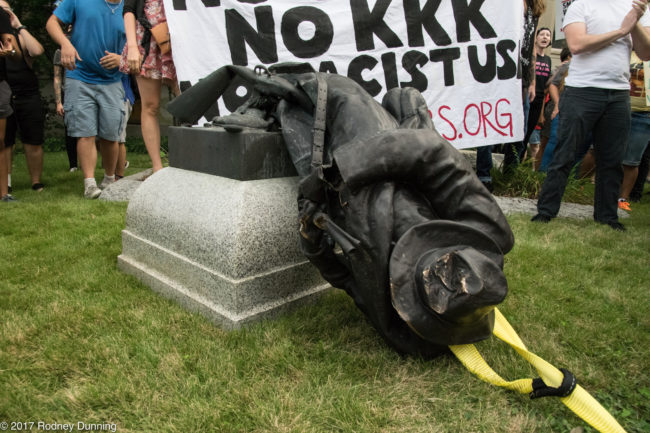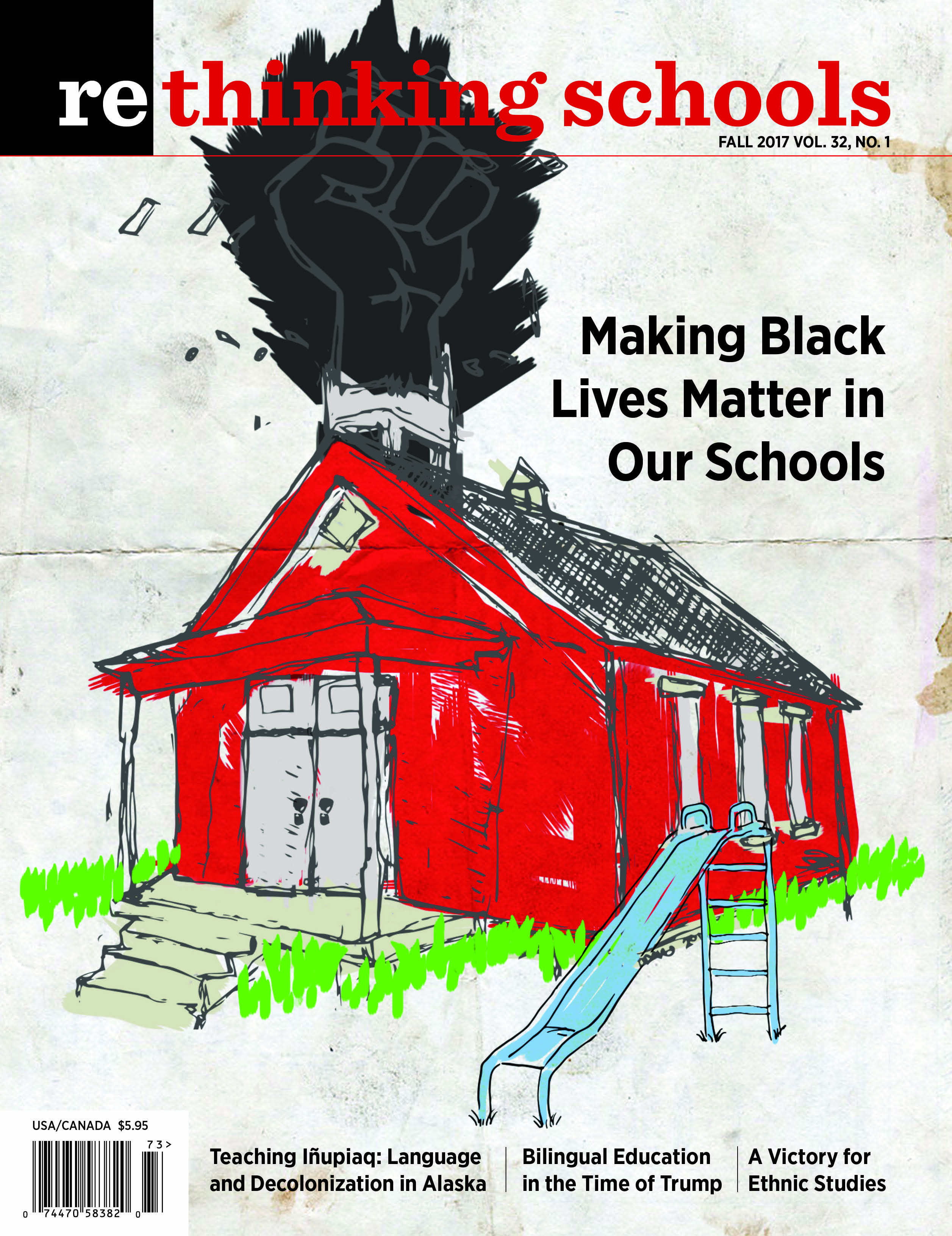[This important article from Rethinking Schools editor Adam Sanchez was first published by the Zinn Education Project (where Adam works developing curriculum and organizing) and Common Dreams. We are republishing it now because the fall issue of our magazine — which has five cover stories and an editorial focusing on Making Black Lives Matter in Our Schools — is hitting mailboxes and newsstands this week. Adam is the co-author of one of the cover stories in the magazine, “What We Don’t Learn About the Black Panther Party — but Should” along with another Rethinking Schools editor, Jesse Hagopian.]
By Adam Sanchez
As a history teacher, there are times when the past reasserts itself with such force that you have to put aside your plans and address the moment. Charlottesville is one of those times. The image of white supremacists openly marching in defense of a Confederate general, viciously beating and murdering those who are protesting their racism — is an image we hoped had died with Jim Crow. That this image is not a relic of the past, is a reality that teachers and students must face as they return to the classroom this year.
In his defense of the white supremacists marching against the removal of a statue of Robert E. Lee, Donald Trump pointed out that George Washington owned people and asked, “So this week, it is Robert E. Lee. I noticed that Stonewall Jackson is coming down. I wonder, is it George Washington next week? And is it Thomas Jefferson the week after? You know, you really do have to ask yourself, where does it stop?”

Many responded to this question by pointing out that unlike Lee, Washington and Jefferson were not best known for their defense of slavery. But The Onion cut to the heart of the President’s position with its headline: “Trump Warns Removing Confederate Statues Could Be a Slippery Slope To Eliminating Racism Entirely.” And activists have been making it clear that they hope this moment won’t end with the removal of Confederate monuments. In the wake of Charlottesville, former Rethinking Schools editor and current Philadelphia city councilwoman Helen Gym has called for the removal of the statue of former mayor Frank Rizzo, known for terrorizing Black and gay communities. In New York City, protesters have demanded the removal of a Central Park statue of Dr. J. Marion Sims, who experimented on enslaved women in the 19th century.
Weighing in on this debate, historian Eric Foner writes, “Historical monuments are, among other things, an expression of power — an indication of who has the power to choose how history is remembered in public places.” In that case, what better way to empower students and teachers in schools across the country, than by actively taking part in the debate over whether symbols of white supremacy should be taken down — whether a statue at a nearby park, a classroom poster, a hallway mural, or even a school name. In fact, according to the Southern Poverty Law Center, 109 public schools, a quarter of which have student bodies that are primarily Black, are named after Confederate icons. In addition to efforts aimed at challenging symbols that represent racism, an equally powerful activity could be discussing, and ultimately taking action around, what names, pictures, and monuments would more accurately reflect the values of your school community.
But eventually, we need to move beyond discussions about tearing down symbols of white supremacy, and begin to strategize about how to tear down the systems that still prop it up. In response to Trump’s query, educator and activist Brian Jones writes, “Where does it stop? Let’s answer him: it goes all the way to the beginning. If we’re serious about uprooting racism and racist violence, we have to write a new American history for every student in every classroom, for every monument and museum.”
If you doubt the need for such a drastic reclaiming of history, you need to look no further than the textbooks adopted by the state of Virginia, where this recent racist violence took place. One of the adopted textbooks, The American Journey, has previously been critiqued by James Loewen for inaccurately implying that states’ rights, not slavery, was the reason Southern states seceded at the beginning of the Civil War. Another, Pearson’s America: History of Our Nation, ends its chapter on Reconstruction with a section titled “A Cycle of Poverty,” that begins, “At emancipation, many freedmen owned little more than the clothes they wore. Poverty forced many African Americans, as well as poor whites, to become sharecroppers.”
But neither poverty nor sharecropping was an inevitable outcome of emancipation. In fact, sharecropping was the result of a compromise between emboldened freedmen who refused to work in gangs under white supervision and ex-slaveholders who needed a workforce to till their land. It wasn’t until the end of Reconstruction, the same period when all those Confederate monuments were built and Jim Crow laws put in place, that a new landlord-merchant class was able to turn sharecropping into a system that kept many Blacks and poor whites in a permanent state of debt, poverty, and dependence.
Furthermore, what’s suspiciously absent from this passage is the discussion of why people who had labored all their lives for no pay, on whose backs the nation’s wealth was built, ended up in poverty — many working for their former “masters” after finally winning freedom from slavery. This textbook — and so many others — offers no suggestion that there were alternatives, like in the Georgia Sea Islands, where 400 freedmen and women divided up land, planted crops, started schools, and created a democratic system with their own constitution, congress, supreme court, and armed militia — that is, until the U.S. Army forced them out and handed their land back to the former slave owners who had abandoned it. Also left out are the millions of Blacks and poor whites who organized together across the South in the Union Leagues through strikes, boycotts, demonstrations, and educational campaigns that fought to make freedom more than simply the freedom to be poor.
In fact, what all the major textbooks have in common — whether adopted in Virginia or New York — is that they give a top-down history of events. This history emphasizes and memorializes presidents, legislators, generals, and the wealthy — the same people who are typically honored with monuments. As Howard Zinn so eloquently wrote:
The result of having our history dominated by presidents and generals and other “important” people is to create a passive citizenry, not knowing its own powers, always waiting for some savior on high. . . . History, looked at under the surface, in the streets and on the farms, in the GI barracks and trailer camps, in factories and offices, tells a different story. Whenever injustices have been remedied, wars halted, women and Blacks and Native Americans given their due, it has been because “unimportant” people spoke up, organized, protested, and brought democracy alive.
As teachers return to the classroom this fall, we need to dedicate ourselves to teaching Charlottesville along with a more honest, full history of the United States. That story can’t be told without centering racism and oppression as crucial to the development of the country, but it also can’t be told without acknowledging those who have fought and died fighting racism and oppression. We need a history that honors the Takiyah Thompsons and Heather Heyers, not the Robert E. Lees. But more than that, we need a history that helps us learn how to move beyond tearing down statues and toward tearing down the racist system that those statues represent.
Check out more articles in our fall issue about making Black lives matter in our schools:
“How One Elementary School Sparked A Citywide Movement to Make Black Students’ Lives Matter” by Wayne Au and Jesse Hagopian
“Beyond Just a Cells Unit: What My Science Students Learned from the Story of Henrietta Lacks” by Gretchen Kraig-Turner
“What We Don’t Learn About the Black Panther Party — but Should” by Adam Sanchez and Jesse Hagopian
“Black is Beautiful” by Kara Hinderlie
“Who Do I Belong To? A Black Teacher’s Dilemma” by Natalie Labossiere
Image credit: Confederate statue in Durham, N.C. toppled by activists in August 2017. Rodney Dunning via Flickr.
Adam Sanchez (adam@rethinkingschools.org) is an editor of Rethinking Schools magazine. Sanchez teaches at Harvest Collegiate High School in New York City and works as curriculum writer and organizer with the Zinn Education Project.

